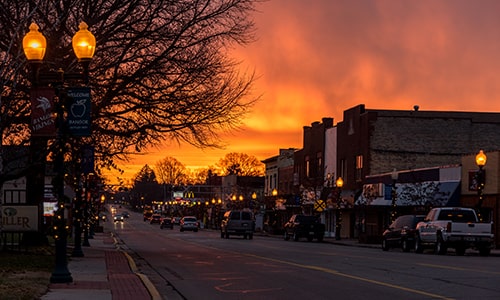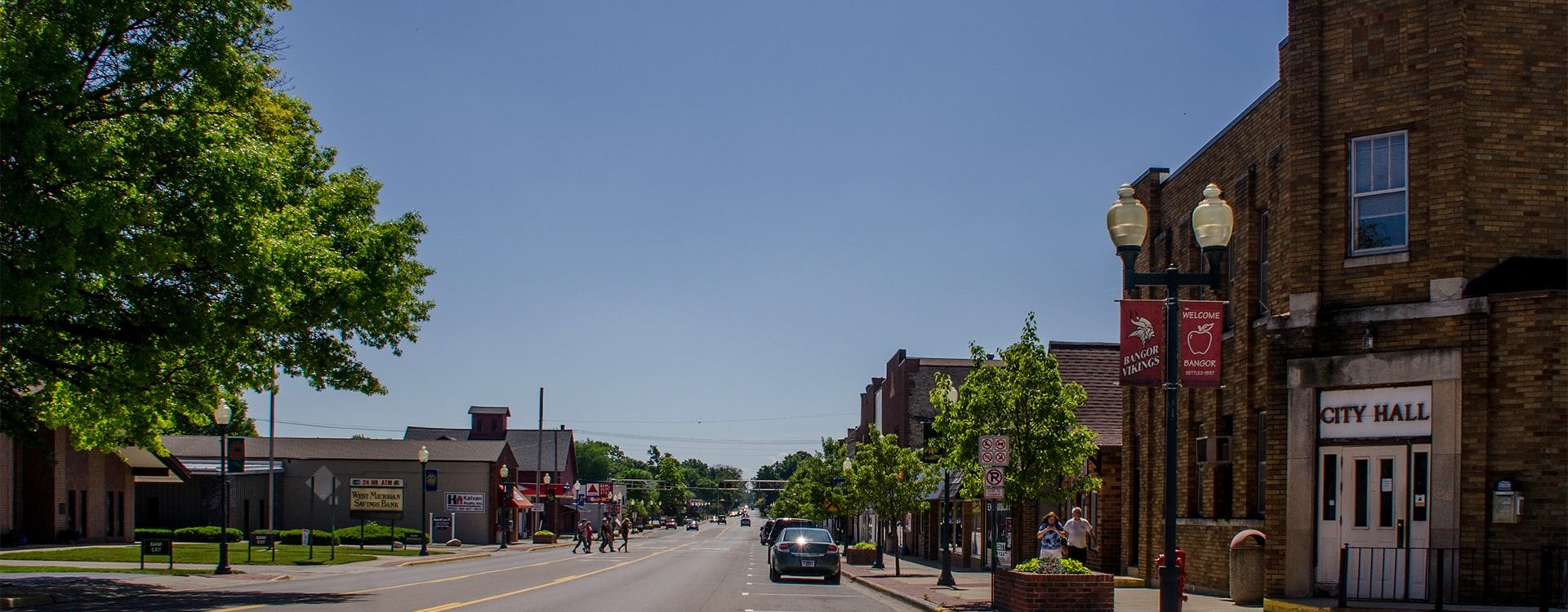About Bangor
Here is a brief history of Bangor from local historian Bob Emmert: 
Present-day Bangor began as a land of towering hardwoods and quiet waterways. These resources would be the reason this area developed into a thriving community. When Charles U. Cross first came in 1835 along with Jay R. Monroe to explore the property his uncle had acquired from the government, it did not take him long to recognize the importance of water and timber as building blocks for a thriving settlement.
By 1846, there were several families in the area. Many helped Mr. Cross build the first water mill on Black River. It was used as a saw mill and was kept busy making those building blocks of what would become the town of Bangor. Several varieties of extremely large trees in a virgin forest were used to make lumber for future homes and stores.
During these early years, the community was considered part of South Haven Township. It was not until October 1853 that Bangor was detached and made into its own township. The new township was called Marion; however, only three days later the name was changed to Bangor. There are a few theories about why this change was made, but the most likely is that it was suggested by a member of the board of supervisors who was originally from Maine.
Joseph H. Nyman came to Bangor in 1856 and became an ambitious entrepreneur who probably had more impact on Bangor’s early development than any other person. After purchasing the Cross sawmill, he made water power the most important element to ensuring future growth. He concentrated his efforts on enlarging and improving the earthen dam that now holds back the present-day millpond. Two more mills would follow on Nyman’s millpond: a cotton mill and a grist mill. Nyman’s three mills and a fourth mill just one mile west of town built by John and Christian Funk became some of the first businesses in Bangor. They provided some employment and goods and services needed to sustain a community.
Settlers were coming to the area in larger numbers in the 1850’s, and the first indications of the community’s retail economic base were beginning to take root. M.P. Watson was the earliest settler to engage in retail business in Bangor in 1852, on what is now the corner of Monroe and Railroad Streets. It would later become a landmark when Horace Sebring made the Sebring House Hotel a thriving establishment. A.B. Taft took on the challenge in 1864 with a general store just north of where today’s depot is located. Brothers James and Elias Ferguson set up a store on the north side in 1866, as did Silas DeLong.
Bangor’s early progress is closely linked to the railroad. It helped drive early economic development and growth within the community. The Chicago and Michigan Lakeshore Railroad laid tracks through Bangor in 1870. Local Businesses and agricultural operations were strengthened by their access to distant markets. Each week, dozens of railroad cars came and left town carrying pig iron, lumber, brick, iron ore, wool, grain, livestock, and agricultural products among many other commodities. The depot and rail yard were alive with activity.
The availability of the railroad brought representatives from a company in 1872 looking for areas of plentiful hardwoods to place a blast furnace. Wood burned into charcoal was needed to aid in the smelting of iron ore to manufacture pig iron. The Bangor Furnace Company contracted land owners to remove anywhere from five to forty acres of timber over a period of two years, free of charge, making way for new and productive farmland. Iron ore was shipped via Lake Superior and Lake Michigan to docks in St. Joseph and transferred into rail cars with a destination of Bangor, where it was unloaded into large piles by the Furnace. In its early years, the Furnace employed 150 men, including teamsters and woodcutters. At its peak, the company employed over 400 men and used 125 teams of horses generating a monthly payroll of over $6000. In its quest to acquire timber for charcoal, the Bangor Furnace Company cleared one square mile of wood every year. When the company went out of business in the late 1880’s, it left a legacy of thousands of acres of fertile farmland for local farmers. This legacy sustained Bangor when over 400 jobs were lost and the community made the shift from an industrial center to a farming community.
From the mid 1860’s to about 1880, the population of Bangor grew from less than 100 settlers to over 1500 residents. In those early years, attempts to create business were met with limited success. It was the railroad that brought the Bangor Furnace Company to the area and created an economic atmosphere of prosperity for local businesses. The legacy of cleared farmland by the furnace cleared the way for agriculture, especially apples, to keep Bangor on its feet and remain a viable town. By bringing people to this area the railroad and furnace company created a need for commerce. It was the resilience of those first settlers to do business and make Bangor a sustainable community that still makes this small city what it is today.
The Bangor Historical Society website is filled with a lot of additional, great information.


